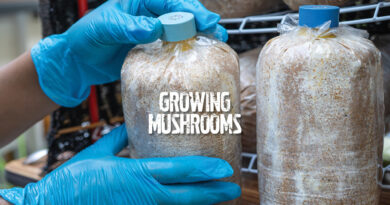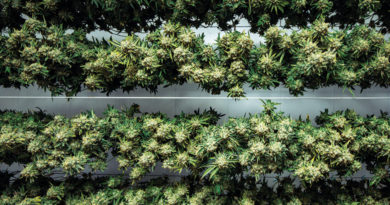The Rise of Rosin
You probably want to grow your plants without chemicals and eat food without added chemicals, so it makes complete sense that it is more appealing to smoke cannabis concentrates made using only heat and pressure. Rosin is made by mechanically pressing marijuana flower, ice hash, or kief under high pressure between heated plates to quickly produce a sappy or shatter like concentrate that can be dabbed, vaporized, or used for cooking.
Like many other things in the cannabis industry, rosin started in basements, using T-shirt presses and hair straighteners. Rosin became mainstream on the west coast around 2015 and gained traction slowly over the years. It has evolved now into the full-scale commercial concentrate production we know today using high-end rosin presses, kief tumblers, and ice extraction methods to expedite the process, however, all these methods can still be done on a smaller scale at home.
 A freshly-pressed puck of flower. | Photo by Kyle LeGrow
A freshly-pressed puck of flower. | Photo by Kyle LeGrow
Flower Rosin
The quickest way to produce rosin is from cannabis flowers. Rosin produced from flowers is generally very floral smelling with a sticky or shatter consistency. Flower rosin has the fullest spectrum out of most concentrates due to certain refining processes removing some cannabinoids, terpenes, and other compounds found in cannabis. Flower rosin can easily be achieved by pressing a potent bud at the desired temperature and time between some parchment paper, but the yield will be significantly less than kief or ice hash pressing. Pressing bags can also be used when producing rosin from a press to achieve higher yields but would not be worthwhile if pressing with a hair straightener as most do not fit.
- Temperatures range: 190°F – 220°F
- Press time: 1–3 minutes
Read also:
 Dry Sift Kief courtesy of Green Cedar Retreat | Photo by Kyle LeGrow
Dry Sift Kief courtesy of Green Cedar Retreat | Photo by Kyle LeGrow
Kief Rosin
Kief, or dry sift, is obtained by sifting your small “sugar” trim that is closest to the flowers when you are trimming or small buds that do not pass quality control. This is done through a dry sift screen or kief tumbler. Collect all the kief and place into your small nylon pouches designed for rosin pressing. At this point you can put your satchel into a pre-press to shape the puck of loose kief and press it down evenly prior to entering the machine. This will help keep the package from blowing out the sides, causing a messy mix of hash and rosin. Pressure should be eased on slowly at first followed by full pressure for the remaining press time. The result is nothing short of amazing, with a deeper yellow or golden color and delicious flavors coming through specific to each strain. Kief rosin is great for the commercial producer as you can easily streamline this method with kief tumblers and presses for a quicker turnover and high yield amongst the various methods.
- Temperature range: 150°F – 190°F
- Press time: 90 seconds – 5 min
 Rosin being pressed from ice hash courtesy of Green Cedar Retreat | Photo by Kyle LeGrow
Rosin being pressed from ice hash courtesy of Green Cedar Retreat | Photo by Kyle LeGrow
Hash Rosin
Rivaling the other rosins in potency when executed correctly, hash rosin can be a delicacy amongst concentrates. This is mainly due to the meticulous concentration process and curing it undergoes prior to being pressed. Properly made ice hash can be full melt to begin with, and to further refine that into rosin only makes things better. Mastering the art of ice extraction, however, will take some trial and error. Temperatures, timing, starting material, clean reverse osmosis water, and equipment are all key factors in producing quality ice hash to press into rosin. After producing the ice hash it’s time to prepare it for pressing. If your hash is condensed, then you will need to grate it to a fine powder-like consistency prior to pressing it.
- Temperature range: 150°F – 190°F
- Press time: 1–5 min
Fire in, fire out. Unlike solvent-based extracts, your starting material is essential to producing quality rosin. Old black hash sitting around that you’re thinking of pressing? You will likely get a dark rosin for the final product. Sticky trichome-covered flowers that you turned into quality full-melt ice hash? Expect some high-grade rosin that is light in color. Because there are no chemicals introduced during the concentration period, the quality of the starting material is a crucial step in producing high-quality rosin.
Unlike many other cannabis-based concentrates, rosin can bring out the full terpene profile of the starting product and is truly in a class of its own.




